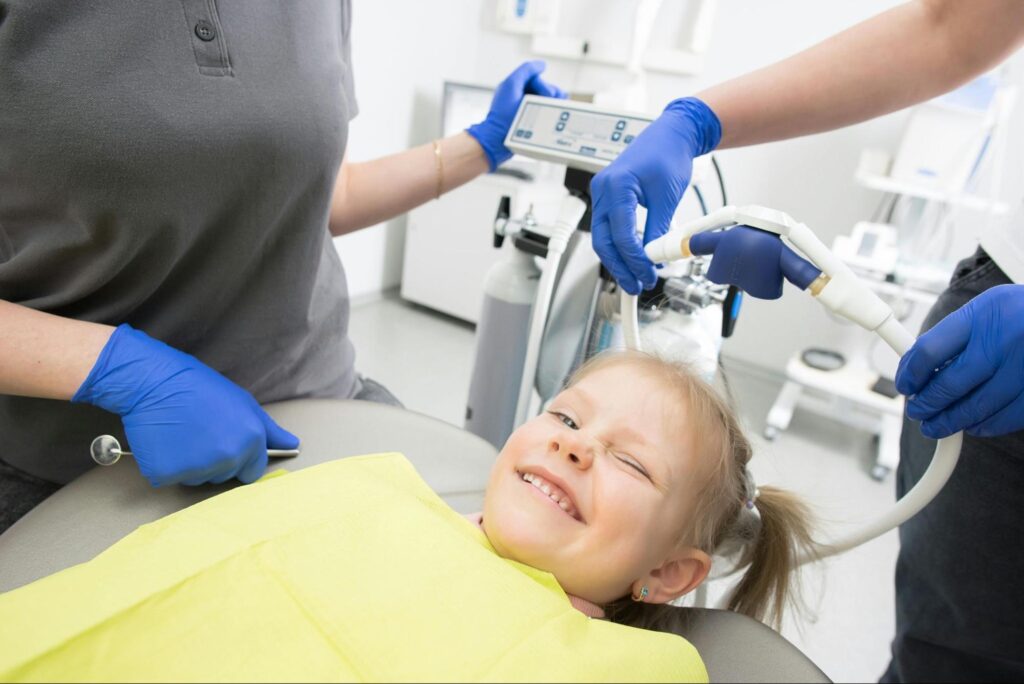
Recent advancements in pediatric dentistry, encompassing laser dentistry, BPA-free dental sealants, and silver diamine fluoride treatments, have transformed the landscape of children’s oral healthcare. These innovations promise not only minimal invasiveness and precise targeting but also enhanced safety and long-lasting protection against cavities. Additionally, the introduction of smart toothbrushes and digital x-rays is revolutionizing oral hygiene practices and diagnostic precision. To understand how these cutting-edge developments contribute to better oral health outcomes for children and how they can be integrated into your child’s dental care routine, further exploration into these topics is essential.
Laser Dentistry
Laser dentistry has emerged as a groundbreaking technique in pediatric care, offering minimally invasive treatments that greatly reduce discomfort and anxiety for young patients. This innovative approach utilizes highly focused light beams to perform various dental procedures, making it particularly effective for soft tissue treatments. One of the important advantages of laser dentistry is its precision, which allows for targeted treatment with minimal damage to surrounding tissues. This reduces the need for sutures and accelerates the healing process, thereby enhancing the overall patient experience.
In addition to its precision, laser dentistry employs water cooling to maintain the tissue at a safe temperature during procedures. This technique not only minimizes thermal damage but also ensures a more comfortable experience for the child. The use of water cooling is especially beneficial in procedures involving soft tissues, such as frenectomies or gum contouring, where maintaining tissue integrity is vital.
Moreover, the incorporation of laser technology in pediatric dentistry significantly decreases the need for anesthesia, further alleviating the stress and discomfort traditionally associated with dental visits. Parents and caregivers can be assured that this advanced technology offers a safer, more efficient, and less intimidating option for their children’s dental care.
BPA-Free Dental Sealants
BPA-free dental sealants represent a significant advancement in pediatric dentistry, offering both safety and efficacy for children’s oral health. These sealants not only provide long-lasting protection against cavities but also guarantee a non-toxic composition, making them a safer choice for young patients. Emphasizing the importance of non-toxic materials, BPA-free options minimize potential health risks while upholding their protective function.
Safe for Children’s Teeth
Ensuring the safety of dental treatments for children, the use of BPA-free dental sealants represents a significant advancement in pediatric dentistry. Traditional sealants have faced concerns over the presence of Bisphenol A (BPA), a chemical linked to various health risks. BPA-free options eliminate these concerns, providing a safer alternative for protecting young teeth from cavities and decay. These sealants act as a barrier, safeguarding the enamel, which is essential for maintaining oral health from an early age.
Complementing these sealants, the use of fluoride toothpaste plays an important role in enamel strengthening. Fluoride helps remineralize weakened enamel, making teeth more resistant to acid attacks from bacteria and sugars in the mouth. This dual approach of using BPA-free sealants along with regular brushing with fluoride toothpaste ensures a thorough strategy for maintaining robust dental health in children.
Parents and caregivers can feel reassured that BPA-free dental sealants not only provide effective cavity prevention but also align with contemporary safety standards. These advancements underscore the commitment of pediatric dentistry to offering treatments that are both effective and safe, promoting long-term oral health and well-being for children.
Long-lasting Protection
Offering durability and extended protection, BPA-free dental sealants are designed to provide a lasting defense against cavities and decay in children’s teeth. These innovative sealants act as a protective barrier, effectively sealing the grooves and pits of molars where food particles and bacteria often accumulate. By reducing the risk of cavity formation, they greatly contribute to maintaining excellent oral health in young patients.
In conjunction with fluoride varnish treatments, BPA-free dental sealants enhance the protective measures available in pediatric dentistry. Fluoride varnish is known for its role in enamel strengthening, making teeth more resistant to acid attacks from bacteria in the mouth. When used together, these treatments offer a dual layer of protection, fortifying the teeth against various oral health challenges.
Moreover, the application of BPA-free dental sealants is a quick and painless procedure, ensuring a stress-free experience for children. The sealants can last several years, providing ongoing protection during the critical stages of dental development. This long-lasting safeguard helps to minimize the need for more invasive dental procedures in the future, promoting a healthier, cavity-free smile. Parents can feel confident that their child’s dental health is being proactively preserved through these advanced protective measures.
Non-Toxic Composition
In addition to their long-lasting protection, one of the most significant advancements in pediatric dental sealants is their non-toxic composition, ensuring they are free from Bisphenol A (BPA). BPA, a chemical commonly found in plastics, has been linked to various health concerns, particularly in children whose developing bodies are more susceptible to toxins. Recognizing the importance of safety, modern pediatric dental sealants now utilize chemical-free products, offering peace of mind for parents and caregivers.
These BPA-free sealants are often formulated with natural ingredients, providing an effective barrier against cavities without compromising the child’s health. The shift towards non-toxic materials in pediatric dentistry reflects a broader trend in healthcare to prioritize patient safety and well-being. By opting for these improved sealants, parents can be assured that their child’s dental health is being managed with the utmost care and consideration for their overall well-being.
Smart Toothbrushes
Advancements in pediatric dentistry have led to the development of smart toothbrushes, which utilize technology to promote effective oral hygiene habits in children. These innovative devices are designed to engage young users through interactive apps that make brushing both fun and educational. By integrating playful elements such as games and rewards, children are encouraged to brush for the recommended two minutes, ensuring thorough cleaning.
Smart toothbrushes also offer essential feedback, which is vital in fostering proper brushing techniques. Sensors within the toothbrush monitor brushing patterns and detect areas that may have been missed. This data is then communicated to the child, often through a connected app, providing real-time guidance on how to improve their brushing habits. Such immediate feedback helps children adopt better practices and understand the importance of maintaining oral hygiene.
Parents can also benefit from these advancements, as many smart toothbrushes allow them to track their child’s brushing habits over time. This enables caregivers to identify any persistent issues and address them proactively with their dental care provider. Overall, smart toothbrushes represent a significant step forward in pediatric dental care, combining technology with education to cultivate lifelong healthy habits in children.
Digital X-Rays
Digital X-rays have revolutionized pediatric dentistry by providing safer, faster, and more accurate diagnostic imaging. Unlike traditional X-rays, digital X-rays greatly reduce radiation exposure, making them a safer choice for children. This is especially important in pediatric dentistry, where minimizing radiation exposure is of utmost significance due to the heightened sensitivity of developing tissues.
In addition to enhanced safety, digital X-rays offer superior image clarity, allowing for more precise diagnoses. The high-resolution images can be viewed instantly on a computer screen, facilitating prompt and effective treatment planning. This immediacy not only reduces the time children spend in the dental chair but also alleviates anxiety, making visits more comfortable for young patients.
Moreover, digital X-rays are environmentally friendly, eliminating the need for chemical processing and film, which are associated with traditional radiography. This technological advancement underscores a commitment to both patient welfare and environmental stewardship.
Parents can feel confident that their child’s dental health is being monitored and managed with the most advanced, safe, and effective tools available. Digital X-rays exemplify how modern technology can enhance the quality of care in pediatric dentistry, ensuring that every child receives the best possible treatment.
Silver Diamine Fluoride
Silver Diamine Fluoride (SDF) is emerging as a revolutionary treatment in pediatric dentistry due to its significant cavity-prevention benefits. This pain-free method not only halts the progression of dental caries but also offers a quick application process, making it particularly suitable for young patients. By incorporating SDF into routine dental care, practitioners can enhance the overall oral health outcomes for children in a compassionate and efficient manner.
Cavity Prevention Benefits
One promising development in pediatric dentistry is the use of Silver Diamine Fluoride (SDF) for effective cavity prevention. SDF offers a thorough, painless method to halt the progression of dental caries, making it particularly beneficial for young patients who may be apprehensive about dental procedures. This innovative treatment not only prevents cavities but also helps maintain the integrity of the tooth structure.
The application of SDF complements other preventive measures, such as fluoride varnish, which is commonly used to strengthen enamel and resist decay. While fluoride varnish remains an essential tool in cavity prevention, SDF provides an additional layer of protection by arresting active decay and preventing further damage.
Moreover, SDF’s efficacy is enhanced when combined with detailed dietary counseling. Educating parents and children about the importance of a balanced diet, limiting sugary snacks, and maintaining proper oral hygiene practices can greatly reduce the incidence of cavities. By integrating SDF, fluoride varnish, and dietary counseling, pediatric dentists can offer a holistic approach to cavity prevention, ensuring better oral health outcomes for children. This multi-faceted strategy underscores the commitment of modern pediatric dentistry to prioritize the well-being and comfort of young patients.
Pain-Free Treatment
As pediatric dentistry continues to evolve, the introduction of Silver Diamine Fluoride (SDF) represents a significant advancement in providing pain-free treatment for young patients. SDF is a topical medication used to halt the progression of dental caries, offering a non-invasive alternative to traditional drilling and filling methods. This innovative treatment is particularly beneficial for children who may experience anxiety or fear associated with dental procedures.
In a child-friendly environment, where the focus is on comfort and trust, SDF serves as an essential tool for minimizing discomfort. The application of SDF does not require local anesthesia or sedation, making it an ideal option for young patients who are apprehensive about needles or sedation options. By avoiding these more invasive measures, SDF helps to reduce the psychological and physical stress associated with dental visits, fostering a more positive experience for both the child and the parents.
Moreover, the pain-free nature of SDF aligns perfectly with the goals of modern pediatric dentistry, which aims to prioritize patient comfort and well-being. This compassionate approach not only enhances the overall dental experience but also encourages children to maintain regular dental check-ups, promoting long-term oral health.
Quick Application Process
The application process for Silver Diamine Fluoride (SDF) is noticeably quick and straightforward, making it an efficient choice for treating young patients. This user-friendly application involves simply cleaning and drying the affected tooth, applying the SDF solution with a micro brush, and allowing it to dry. The entire procedure typically takes only a few minutes, which is particularly important for children who may have limited patience or experience anxiety during dental visits.
One of the primary benefits of this efficient scheduling is the ability to treat multiple teeth in a single appointment, reducing the need for repeat visits. This is essential not only for the convenience of parents but also for minimizing the stress and discomfort for the child. Additionally, the non-invasive nature of SDF application means that it can be performed without the need for local anesthesia or drilling, further enhancing the patient experience.
Pediatric dentists appreciate the ease of integrating SDF into their practice due to its minimal preparation and application time. This streamlined process allows for more efficient time management, enabling clinicians to focus on delivering thorough care. Consequently, the rapid and user-friendly application of SDF greatly enhances the overall efficiency and effectiveness of pediatric dental treatments.
Minimally Invasive Techniques
Minimally invasive techniques in pediatric dentistry prioritize preserving natural tooth structure while effectively addressing dental issues, thereby reducing discomfort and promoting quicker recovery for young patients. One such technique is air abrasion, which employs a stream of tiny particles to remove decayed tooth material gently. This method is particularly advantageous for children as it often eliminates the need for traditional drills, making the experience less intimidating and more comfortable. Air abrasion not only conserves more of the healthy tooth but also minimizes the risk of microfractures.
Another notable advancement is resin infiltration, a method used to treat early-stage cavities and white-spot lesions without the need for drilling. Resin infiltration involves the application of a special resin that penetrates the enamel, effectively halting the progression of decay. This technique is beneficial for young patients as it avoids the need for more invasive procedures and preserves the tooth’s natural structure.
Painless Anesthesia
Innovations in painless anesthesia are revolutionizing pediatric dentistry by greatly reducing the anxiety and discomfort associated with dental treatments for children. This transformative approach encompasses a range of techniques designed to provide effective pain management while minimizing the fear often linked with dental visits.
One of the most significant advancements in this field is the use of topical anesthetics. These are applied directly to the gum tissue, numbing the area and making the subsequent injection of local anesthetics virtually painless. The development of more effective and fast-acting topical anesthetics has made it easier for pediatric dentists to perform various procedures without causing distress to young patients.
Additionally, sedation dentistry has become a cornerstone in painless pediatric dental care. This method involves administering sedative medications to help children relax during dental treatments. Depending on the child’s age, medical history, and level of anxiety, various forms of sedation—such as nitrous oxide, oral sedatives, or even intravenous sedation—can be employed. These techniques ensure that children remain calm and comfortable, greatly enhancing their overall dental experience.
Orthodontic Advances
Orthodontic advances in pediatric dentistry have greatly improved early intervention techniques, allowing for timely and effective treatments. The introduction of clear aligners for children offers a more comfortable and aesthetically pleasing alternative to traditional braces. Additionally, digital imaging technologies enhance diagnostic accuracy and treatment planning, ensuring excellent outcomes for young patients.
Early Intervention Techniques
Early intervention techniques in pediatric orthodontics are essential for guiding proper dental development and promoting future complications. These techniques are pivotal in guaranteeing that a child’s oral structure develops correctly from a young age. One of the key components of early intervention is growth monitoring. By closely observing a child’s dental growth patterns and jaw development, orthodontists can identify potential issues such as misaligned teeth or jaw discrepancies early on. This proactive approach allows for timely interventions that can minimize the need for more extensive treatments later in life.
Another critical aspect of early intervention is habit counseling. Certain habits, such as thumb sucking or prolonged use of a pacifier, can adversely affect dental alignment and bite. Through habit counseling, pediatric dentists educate both children and parents on the impacts of these habits and provide strategies to overcome them. This guidance is instrumental in preventing the development of malocclusions and other dental issues.
Incorporating these early intervention techniques into a child’s dental care plan not only promotes healthier dental development but also sets the foundation for a lifetime of excellent oral health. By addressing potential concerns early, pediatric dentists can help ensure that children grow up with strong, healthy smiles.
Clear Aligners for Kids
The advent of clear aligners in pediatric dentistry represents a significant leap forward in providing discreet and effective orthodontic treatment for children. Unlike traditional metal braces, clear aligners offer a virtually invisible solution, making them particularly appealing to children who may feel self-conscious about their appearance during treatment. These aligners are custom-made to fit each child’s unique dental structure, ensuring excellent comfort and efficacy.

From a cost comparison perspective, clear aligners can sometimes be more expensive upfront than traditional braces. However, the benefits often justify the investment. Clear aligners typically require fewer office visits for adjustments, which can translate to savings in both time and money for busy families. Additionally, the aligners can be removed for eating and cleaning, contributing to better oral hygiene and reducing the risk of cavities and gum disease during treatment.
In terms of treatment duration, clear aligners can be just as effective as traditional braces, often achieving the desired results in a comparable timeframe. Many cases see significant improvement within 12 to 24 months, depending on the complexity of the dental issues being addressed. This advancement in orthodontic technology not only enhances the aesthetic experience but also supports overall dental health, making it a valuable option for modern pediatric dentistry.
Digital Imaging Benefits
Building on the innovations in clear aligners, digital imaging has revolutionized orthodontic treatment planning and execution in pediatric dentistry. This advanced technology offers significant advantages, especially in radiation reduction and enhanced diagnostics. Digital imaging systems, such as digital X-rays and 3D imaging, emit far lower levels of radiation compared to traditional radiography, making it a safer option for children who require frequent monitoring of their dental development.
Moreover, digital imaging delivers enhanced diagnostics, providing highly detailed and accurate images of a child’s oral structures. This precision allows for early detection of potential issues, such as misaligned teeth, impacted teeth, and jaw abnormalities. Early intervention can prevent more complex problems and reduce the duration and cost of orthodontic treatments.
Digital imaging also facilitates more effective communication between the dentist, orthodontist, and parents. Visual aids and 3D models can help in explaining treatment plans, fostering a better understanding and cooperation from both children and their guardians. Ultimately, the integration of digital imaging in pediatric dentistry underscores a commitment to providing safer, more efficient, and thorough care, ensuring that young patients receive the best possible outcomes in their orthodontic journeys.
Teledentistry Services
As technology continues to evolve, teledentistry services are emerging as an essential tool in improving access to pediatric dental care. Through remote consultations and virtual checkups, teledentistry breaks down geographical and logistical barriers, ensuring that more children receive timely and professional dental care. This innovative approach allows parents to secure expert advice without the need for an in-person visit, which is particularly beneficial for families in rural or underserved areas.
Teledentistry involves the use of video conferencing and digital communication tools to conduct preliminary assessments, monitor ongoing treatments, and provide educational resources. For instance, a virtual checkup can help identify oral health issues early, guiding parents on the next steps before a situation worsens. This proactive approach not only minimizes the risk of dental emergencies but also fosters a culture of preventive care.
Another significant advantage is the reduction of anxiety that some children experience during traditional dental visits. By interacting with their dentist in a familiar home environment, children can become more comfortable with dental care procedures. Additionally, teledentistry enables continuous follow-up, ensuring that treatment plans are adhered to and adjusted as needed, further enhancing the overall quality of pediatric dental care.
Preventive Care Programs
In addition to the benefits of teledentistry, implementing robust preventive care programs is fundamental to maintaining long-term pediatric dental health. Preventive care programs are designed to address dental issues before they become significant problems, promoting a proactive approach to dental management. Central to these programs is thorough dental education for both children and their parents. Educating families about proper oral hygiene practices, such as regular brushing and flossing, empowers them to take control of their dental health and instill lifelong habits in children.
Another critical component of preventive care is the application of fluoride varnish. Fluoride varnish is a highly effective treatment that strengthens tooth enamel, making it more resistant to decay. This treatment is particularly beneficial for young children, who are at increased risk for cavities. Regular applications of fluoride varnish can greatly reduce the incidence of dental caries, ensuring healthier smiles.
Preventive care programs also include routine dental check-ups and cleanings, which help in early detection and intervention of potential issues. By integrating dental education and fluoride varnish into these programs, pediatric dentistry can significantly improve the oral health outcomes for children, fostering a foundation for a lifetime of healthy teeth.
Behavioral Management
Effective behavioral management is crucial in pediatric dentistry to guarantee a positive and stress-free experience for young patients. Modern advancements in this area focus on creating a welcoming environment that reduces anxiety and fosters cooperation. One pivotal strategy is positive reinforcement, which involves rewarding children for good behavior during dental visits. This can range from verbal praise to small rewards, making visits more enjoyable and encouraging future compliance.
Effective communication techniques are also paramount. Dentists are trained to use child-friendly language, ensuring that instructions and explanations are easily understood. Techniques such as ‘tell-show-do’—where the dentist explains the procedure, demonstrates it and then performs it—help demystify dental treatments, reducing fear and apprehension.
Additionally, creating a child-centric environment, complete with engaging visuals and interactive elements, can greatly ease nerves. Pediatric dentists often employ storytelling and distraction methods to keep young minds occupied during procedures. By integrating these behavioral management techniques, pediatric dentistry not only enhances the immediate dental experience but also promotes a lifelong positive attitude towards oral health. This holistic approach ensures that children feel secure and valued, laying the groundwork for a lifetime of healthy dental practices.
Nutrition and Oral Health
Understanding the impact of nutrition on oral health is essential to ensuring thorough pediatric dental care. A balanced diet plays a pivotal role in the development and maintenance of healthy teeth and gums in children. Dietary choices can either enhance or undermine oral health; hence, it is important for parents and caregivers to be well informed.
Sugary snacks and beverages, for instance, are a major contributor to tooth decay. When consumed frequently, these foods foster an environment where harmful bacteria thrive, leading to cavities. Encouraging children to opt for nutritious alternatives like fruits, vegetables, and dairy products can greatly reduce these risks. Additionally, the habit of drinking water instead of sugary drinks aids in the natural cleansing of the mouth, washing away food particles and bacteria.

Vitamin intake also holds significant importance. Vitamins such as A, C, and D are essential for maintaining oral health. Vitamin A promotes saliva production, which helps clean the mouth; Vitamin C is crucial for gum health, preventing conditions like gingivitis; and Vitamin D aids in the absorption of calcium, strengthening teeth. Integrating a diet rich in these vitamins can lay the foundation for a lifetime of strong and healthy teeth.
Frequently Asked Questions
How Often Should My Child Visit the Dentist for Routine Check-Ups?
Children should visit the dentist every six months for routine check-ups. This visit frequency is essential for implementing preventive measures, ensuring oral health, and detecting potential issues early, contributing to your child’s overall well-being.
At What Age Should My Child Start Using Fluoride Toothpaste?
Your child should start using fluoride toothpaste at the age of two. Initially, use a smear of toothpaste with an appropriate fluoride concentration and child-friendly toothpaste flavors to encourage good brushing habits.
Are Dental X-Rays Safe for Young Children?
Yes, dental X-rays are important for young children, especially with the use of digital radiography, which greatly reduces radiation exposure. Ensuring minimal radiation, these x-rays are vital for early detection and prevention of dental issues.
What Are the Signs That My Child Might Need Braces?
Signs that your child might need braces include crooked teeth, overbite issues, difficulty chewing, or speech impediments. Early consultation with an orthodontist can provide a thorough assessment and suitable treatment plan to address these concerns effectively.
How Can I Help My Child Overcome Fear of Dental Visits?
To help your child overcome the fear of dental visits, use positive reinforcement and engage in role-playing games. These strategies create a supportive environment, familiarizing them with the process and reducing anxiety through repeated, positive experiences.












